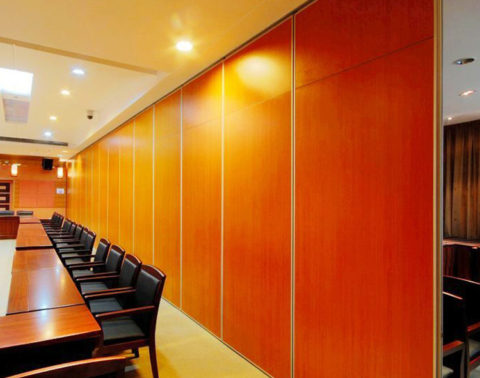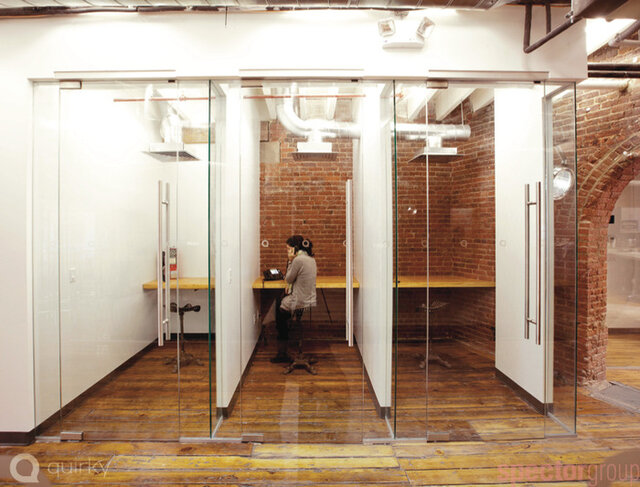Cubicle noise reduction is a pressing concern in modern workplaces which highlights the significant dissatisfaction among cubicle workers with the prevailing noise levels. While open-plan offices draw a lot of criticism, cubicles aren’t as noise-free as we’d like them to be either. Research from the University of Sydney found that lack of sound privacy is the number one frustration for cubicle workers—and 30% of cubicle workers are dissatisfied with noise level.
From investing in noise-cancelling headphones to strategically placing sound-absorbing materials, there are plenty of options to explore for cubicle soundproofing and creating a more tranquil work environment.
1. Install soundproofing partitions

One simple cubicle noise reduction trick is to install soundproof partitions. These can be floor-to-ceiling or shorter and are made of thick, sound-dampening material that blocks some of the noise between cubicle walls. As an added bonus, partitions also improve privacy between cubicles.
2. Hang sound blankets
Typically made of thick cotton and polyester material, sound blankets can be hung on walls or draped over windows and doors to dampen sound. If your cubicle neighbor’s conversations bother you, you can hang a sound blanket over the part of the cubicle that shares a wall with them. It’s an easy way to create an extra buffer between you and the source of noise.
3. Install a noise-cancelling app
When all’s said and done, you can soundproof your cubicle as much as possible, but you’ll never be able to block out all sounds. If background noise is ruining your calls, the best solution is one of the best noise-cancelling apps for windows like Krisp that works from within your microphone to eliminate distracting sounds during your meetings.
[demo-new]
Krisp’s AI technology has been trained by listening to thousands of hours of audio, so it knows which sounds are background noise that should be blocked. What’s more, it works with any headset or software you might currently be using. You might not be able to escape your cubicle’s noisy environment, but at least it won’t ruin your phone and video meetings.
4. Acoustic panels
A space with tall ceilings and little furniture can amplify sound, so one way to cut down on echoes is to install acoustic panels on your office walls. These pieces of foam absorb sound so it doesn’t bounce off the walls and create even more noise in the office.
5. Put up acoustic ceiling tiles
Consider putting up acoustic ceiling tiles made of fiberglass or wool to absorb excess sound in your workspace. You’ll particularly benefit if you’re in an office with tall ceilings, which can really intensify echoes. Be prepared to make the investment, though. According to Fixr, the cost of installing a suspended acoustic ceiling averages $1,494 for 130 square feet.
6. Fill the space with furniture, rugs, plants, etc.
Another way to cut down on how much sound travels through your office is to fill your space with sound-absorbing items. Think large, soft, and cloth, like sofas, rugs, ottomans. Even big canvas paintings may do the trick in stopping those pesky sound waves from bouncing around your workplace.
7. Change your flooring
If you’ve got hard flooring such as tile or wood, consider switching it out for a softer material. Soft flooring like carpet has sound-dampening effects, especially if foot traffic is causing a lot of noise.
8. Install sound masking systems
More than mere white noise, sound masking consists of playing unobtrusive audio engineered at specific frequencies that will make background speech unintelligible. So while it won’t “block out” all distracting sounds per se, it will prevent your coworkers’ conversations from derailing your train of thought.
Many offices install these sound masking systems for both privacy and productivity, but it’s not cheap. It can cost anywhere from $1 to $2 per square foot, according to Todd Berger of Cambridge Sound Management.
9. Increase the distance between cubicles
This solution works especially well if your office has shifted to a hybrid model, where some coworkers are working from home. With more space, you can spread out cubicles farther and decrease the sound that reaches each coworker.
10. Increase cubicle wall height
If you can’t extend horizontal space, think vertical. Invest in taller partitions between cubicles to block out excess noise and improve privacy (win-win!). Some partitions are thick, insulated glass, while others are made of a fabric, such as polyester fiber.
11. Create a quiet room
Sometimes, you don’t need to do away with cubicles altogether. It’s really just about designing your office space based on sound zones. Consider creating a quiet room where employees can retreat to when they need to focus on some deep work.
12. Create a call room
In contrast to the quiet room, a call room can be a conference room or even a phone-booth-type installation where employees can go to make or take calls without disturbing their coworkers. These call rooms typically are enclosed (four walls and a roof) and outfitted with special soundproofing material.
13. Draft an office noise policy
Every cubicle noise reduction strategy can be enhanced by an office noise policy. Draft a document that clearly outlines best practices when it comes to hosting meetings, having conversations with coworkers, and the like. For example, you might instruct employees to only hold lengthy conversations in conference rooms or to always keep the break room door shut so as not to disturb those working in their cubicles.
By having your noise policy documented, you’ll not only reduce unnecessary noise in the office, but you’ll also reduce stress because employees will know what’s expected of them.
14. Crack down on keyboards
You can’t help the click-clacking sounds of keyboards, but the worst culprits are mechanical keyboards, which have switches beneath each key that create a more tactile feel but also more sound. You can cut down on distracting noise by investing in quiet keyboards for your office staff.
15. Play white noise
White noise is a quick and simple cubicle noise reduction hack. Just look up “white noise” on YouTube or use an app like SimplyNoise to hear a low-level, static noise that’ll drown out other sounds. I personally love turning on a HEPA air purifier while I’m working because of the white noise it provides. And hey, if it provides me with cleaner air, too, all the better!
16. Use noise-cancelling headphones
Noise-cancelling headphones do best cancelling out low, constant sounds (like the hum of an airplane engine). They’re not really meant for drowning out the shrill sounds of your coworker’s laugh. Even so, based on some rave Amazon reviews of Bose noise-cancelling headphones, they do a good job of drowning out noises of an open-plan office space. So, it’s worth a shot!
17. Put in earplugs
Earplugs are a cheap and sneaky cubicle noise reduction strategy. If you want to be super stealthy and get extra noise protection, slip a pair of noise-cancelling headphones over the earplugs. No one will be the wiser.
18. Put on safety earmuffs
Yes, safety earmuffs, as in the kind you wear to protect your ears from loud noises at a shooting range. It may seem extreme, but plenty of office workers use safety earmuffs to drown out your run-of-the-mill office noise.
In college, I lived in an apartment where I shared a wall with a DJ. His music was so loud I could feel the vibrations. To get any studying done, I used to wear earplugs with safety earmuffs over them and turn on my HEPA filter for white noise.
19. Consider a work-from-home model
If there’s anything that the past 17 months of this pandemic have taught us, it’s that remote work really can work. For some, one of the benefits of working from home has been greater control over the amount of noise present. Without dozens of coworkers around, some remote employees have found it home to be a more peaceful environment. So one cubicle noise reduction strategy might just be to get rid of the cubicle altogether by going remote.

20. Start offering private, enclosed offices (at least for some roles)
If getting people back into the office is important for team collaboration, consider offering enclosed offices, at least for some roles. For example, your sales team likely has to make a lot of calls due to the nature of their job. Perhaps they’re the ones making the most noise in the office. In that case, offer dedicated office spaces for these roles. It’ll make the entire workplace quieter, especially for those who still need to work from cubicles.
Cubicle Noise Reduction: Peace and Quiet Is Within Your Reach
Cubicles are a classic office setup, and they allow for some privacy and sound reduction at a lower cost to organizations compared to private offices. However, they’re still not the best at cutting down on noise.
Consider incorporating cubicle soundproofing materials or cubicle noise reduction strategies like acoustic panels or noise-canceling devices to create a more conducive work environment for your team.
Additionally, consider utilizing technology to combat cubicle noise and ensure background noise cancellation. Krisp, a noise-cancelling app, works wonders by muting background noises during calls, ensuring crystal-clear communication even in bustling office environments. Integrating Krisp into your daily routine can help minimize distractions and enhance concentration, making it a valuable tool for cubicle dwellers seeking tranquility amidst the noise.



